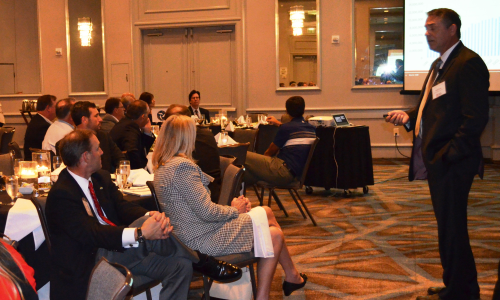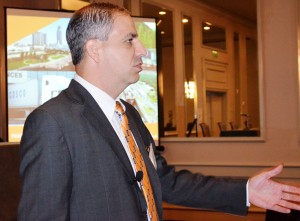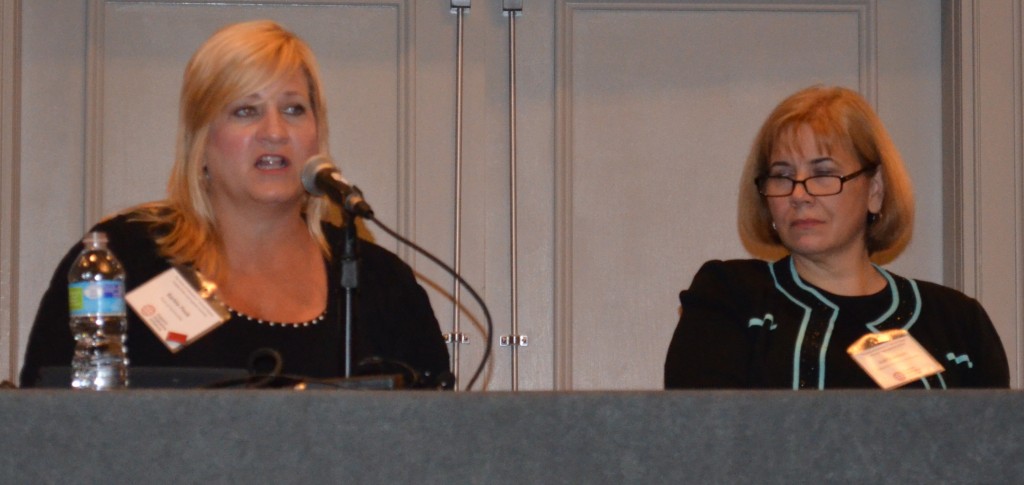Alabama companies build stronger supply chains

Moving raw materials and goods into, out of and within Alabama can be both easy and complex.
The State of Alabama Third Annual Global Supply Chain & Logistics Summit in Hoover on Aug. 19 aimed to tilt the scales more to the easy side for those who make a living with supply chain and logistics management.

The “best practices” panel included, from left, Len Suelter, vice president of business development Nidek Medical Products Inc.; Stephen Noble, vice president of sales and marketing systems at Phifer Inc.; Robert Fuqua, president and CEO of Atlas RFID Solutions; and moderator, Michael Brooks, assistant director of the Alabama International Trade Center.
The Port of Mobile, inland waterways, railway lines and facilities like Norfolk Southern’s Birmingham Regional Intermodal Facility and the international air cargo capabilities of the Port of Huntsville are among the state’s assets when it comes to moving products to parts of Alabama, the U.S. and the world.
Attendees to the conference heard from several of the state and industry experts at the event, including some of the best practices and even some “learn from our mistakes” advice.
Judith Adams, vice president of marketing for the Alabama State Port Authority, said millions of dollars have been and are being invested expanding the Port of Mobile’s capabilities ranging from the size of ships that can use the port to the types of cargo that can be easily shipped to and from the port.
“We do take a pulse of the business community to find out what they need the port to be today and what they will need it to be tomorrow,” Adams said.
Beyond the cargo capabilities, Adams said the Port is making other improvements like automation, information technology and better processes that help make the physical work of moving cargo more efficient.
One of the greatest contributors to the port’s growth is its increased capability to handle shipping containers. APM Terminals operates the primary container facility at the Port of Mobile.

Denson White, client services manager with APM Terminals, said the Port of Mobile is steadily growing its capacity for shipping cargo containers.
Denson White, client services manager with APM, said the company operates on 80 acres and is preparing to expand an additional 40 acres.
White said the APM Terminal has two cranes to transfer the containers to and from ships with an annual capacity of 350,000 TEUs, or “twenty-foot equivalent units,” a common measure in the industry. The expansion will add two more cranes and boost the annual capability to 600,000 TEUs.
An expanded refrigeration facility will enable the shipping of more poultry and other products through the port.
Other planned improvements at the port will make it possible to move containers on barges along Alabama’s inland waterways and will make it faster and easier to move containers onto rail for transporting into the state and throughout the country.
Moving containers and other cargo on the inland waterways will likely require other improvements to inland ports, officials said.

Tim Parker, left, president and chairman of Parker Towing Co., and Randy Bayles, director of international intermodal with Norfolk Southern Corp., served on the transportation sector panel.
Parker Towing Co. moves barges up and down Alabama’s inland waterways. Tim Parker, president and chairman of Parker Towing Co., said while the waterways are well-established when it comes to moving agriculture, petroleum, wood products, building materials and coal, more advanced shipping on the inland rivers would require substanital improvements.
“Inland ports lack the infrastructure – the docks, the cranes, the rail – to support container on barge traffic,” he said.
Adams agreed.
“The inland waterways are under-funded, under-maintained and under-utilized,” Adams said. “It is a resource we need to be taking better care of. It’s an asset.”
Another asset in the state when it comes to moving cargo is the Port of Huntsville. Barbie Peek, director of business development at the Port of Huntsville, said Huntsville is the state’s only international air cargo site.

Barbie Peek, left, the director of business development with the Port of Huntsville, and Judith Adams, vice president of marketing with the Alabama State Port Authority, served on the transportation sector panel.
“Companies choose air cargo when speed is of the utmost importance – even more than with rail,” she said. She said air cargo costs more than moving products by rail, but the industries that value speed are willing to pay for it.
The Alabama Global Supply Chain & Logistics Summit also included a “best practices” panel moderated by Michael Brooks, assistant director of the Alabama International Trade Center. Robert Fuqua, president and CEO of Atlas RFID Solutions; Len Suelter, vice president of business development with Nidek Medical Products Inc.; and Stephen Noble, vice president of sales and marketing systems at Phifer Inc., shared the things there companies have learned and are doing in international trade.

Randy Bayles, director of international intermodal with Norfolk Southern Corp., delivered the keynote address.
Randy Bayles, director of international intermodal with Norfolk Southern Corp., delivered the keynote address. Tom Dadmun, manufacturing ambassador with Frost & Sullivan, opened the conference with a presentation on business intelligence and analytics for supply chain managers.
Presented by the International Trade Division of the Alabama Department of Commerce, the Export Alabama Alliance and the Birmingham Business Alliance, the summit was sponsored by the Alabama State Port Authority, the Alabama International Trade Center, APM Terminals, Page & Jones, Port of Huntsville, Alabama Power Co., Kuehne & Nagel, and the Alabama Automotive Manufacturers Association.
— Michael Tomberlin





